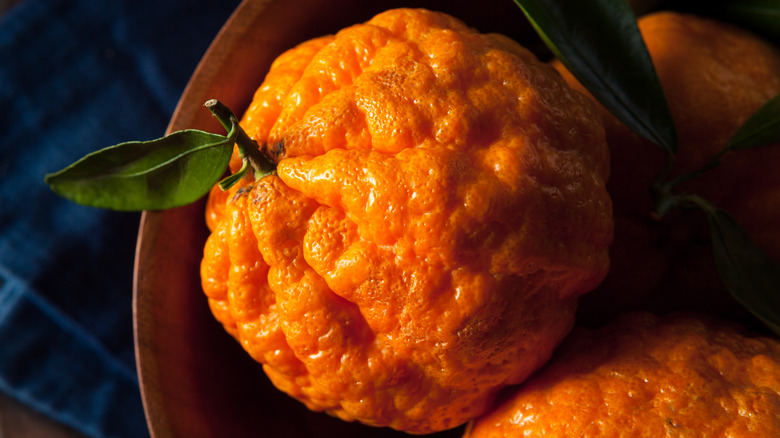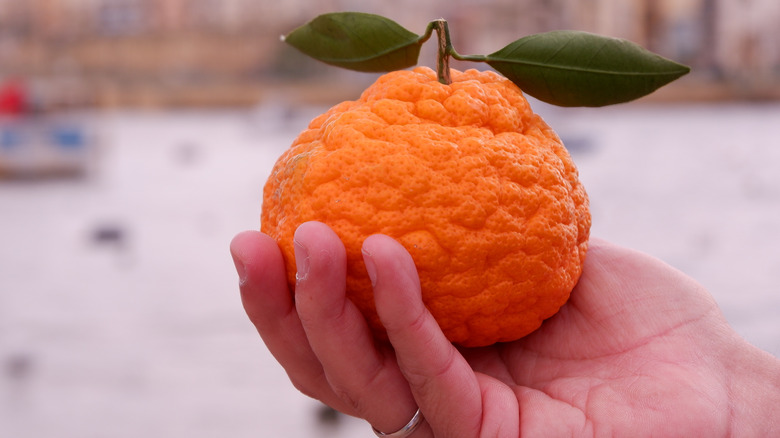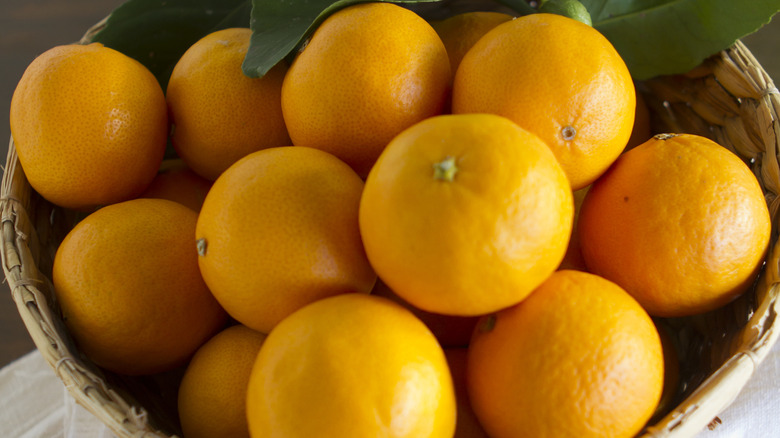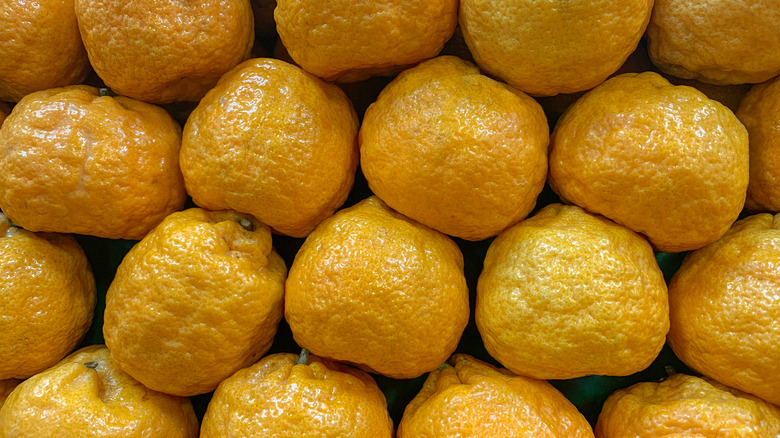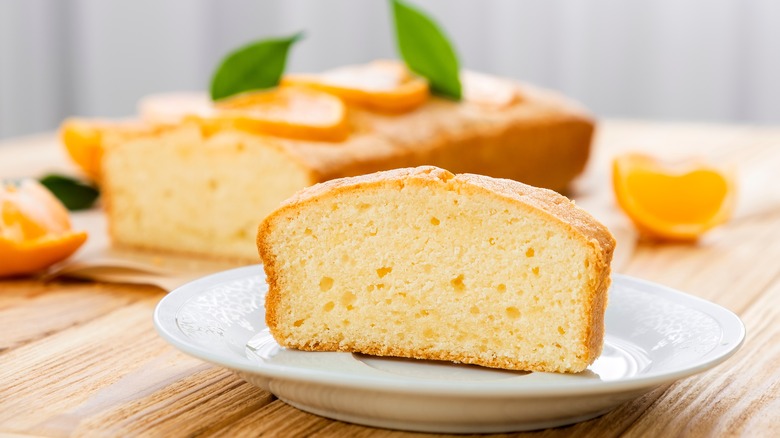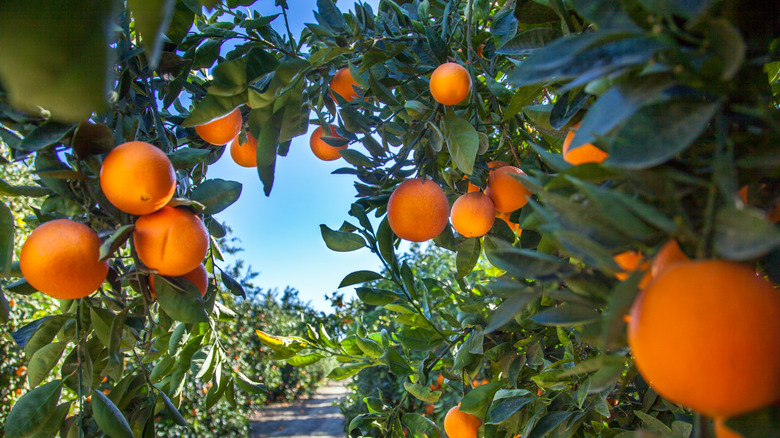The California Tangerine Variety Created By University Scientists
Since California's nickname is the Golden State, it's only right that Gold Nugget tangerines hail from there. In fact, the meaning of the citrus fruit's name goes even deeper than that, as the Sierra mountain range in California has produced some of the largest gold nuggets in history, per Roaring Camp Mining Co. But while real gold nuggets are rock-hard, Gold Nugget tangerines are known for being succulent and especially juicy.
The Gold Nugget may be a lesser-known variety of tangerine, but those who have tried it are fully enamored with the fruit. While it can be enjoyed on its own as a snack, it's also delicious when paired with sweet and savory ingredients. For instance, The Mercury News recommends throwing it into a salad with arugula, olive oil, rice vinegar, and fresh goat cheese. This little beauty is even considered by professionals to be one of the best-tasting citrus fruits in the world. What makes it so outstanding, and who made it that way? Let's dig into this California tangerine and find out.
What are Gold Nugget tangerines?
Perhaps the reason why Gold Nuggets are among the most delicious citrus fruits out there is because they were actually man-made, so their flavor was created on purpose. This variety was bred in the 1950s at the University of California (UC), Riverside, from Wilkling and Kincy tangerines. The latter is the most popular tangerine in the U.S. during the holiday season, while Wilkling tangerines are known to be shiny and oblate in shape. The Riverside origins of Gold Nuggets aren't random, as the county was one of the main citrus-growing areas in California during the late 19th century. In the early 20th century, the Citrus Experiment Station was established there, where thousands of different types of citrus were cultivated.
The UC Riverside scientists have produced an exceptional tangerine with the Gold Nugget. These fruits have a slightly bumpy rind that is easy to peel, and they're completely seedless, making them a great snack for children. They're typically orange (or yellow-orange) on the outside and inside, medium-sized, and inherit their slightly oblate shape from their Wilkling parents.
The scientific name for Gold Nuggets is Citrus reticulata, and they are in the Rutaceae family. As part of the mandarin orange species, tangerines are close relatives of other citrus fruits like oranges, lemons, limes, and grapefruits.
Gold Nugget tangerines vs. Pixie tangerines
When Gold Nuggets were first being bred, they were often compared to Pixie tangerines. And for good reason — both of these citrus fruits were created at UC Riverside in the 1900s and share the Kincy tangerine as a parent, although Pixies came before Gold Nuggets in 1927. The two are similar in other ways as well: They're both seedless, extremely juicy with a bumpy rind, and not perfectly round (Pixies are slightly oval-shaped).
However, Gold Nugget and Pixie tangerines differ in a few key ways. Pixies are pale orange — a lighter color in comparison to the Gold Nuggets' vibrant orange and yellow shades. Pixies also tend to be pretty small — hence their name — at about one to three inches in diameter, while Gold Nuggets are usually larger, resembling the size of oranges more than that of tangerines.
Additionally, though both of these citrus fruits are late-season varieties, Gold Nuggets ripen from February to June, while the peak season for Pixies is during March and April.
What do Gold Nugget tangerines taste like?
If you can get your hands on a Gold Nugget tangerine, you're in for a treat. Professional taste panels have deemed these little gems to be some of the most delicious tangerines in the world. Part of the reason why this variety is so tasty is because it contains about 50% juice, per Melissa's Produce.
Gold Nuggets are succulent, citrusy, and exceptionally sweet compared to other tangerines. Their sweetness overpowers their sourness because they have high sugar content and only a little tang. To give you an idea of how sweet these tangerines truly are, we can look at their Brix value, a measurement used to determine the level of sweetness in produce. According to Cornell Law School, the average tangerine has an 11.5 Brix value. Gold Nuggets, on the other hand, average 15 to 17.5 on the Brix scale (via Bristol Farms).
The flavor of these fruits could also be described as peppery, which can make them an excellent ingredient in savory dishes like roasted fish or tapenade.
How to cook with Gold Nugget tangerines
The easiest way to enjoy these juicy fruits, of course, is to simply peel and eat them as a snack. But Gold Nugget tangerines can also make an excellent addition to a variety of sweet and savory recipes. They add sweetness, juiciness, and a little acidity to whatever dish they're in. They work well in a variety of breakfast foods, including smoothies, yogurt, grain bowls, and cereal. You can also use Gold Nuggets to flavor desserts, such as ice cream, and baked goods like cake, cookies, and muffins. Or, for a delicious chocolate orange alternative, try dipping these tangerine slices into melted chocolate.
But the options don't end there — Gold Nuggets have a firm foothold in savory recipes too. For example, The Mercury News recommends cooking slices of the tangerine with caramelized fennel, green garlic, white wine, and chicken stock, then adding prawns or scallops for a flavorful seafood dinner. Or cut the citrus fruit into cubes and turn them into salsa with jalapeño, cilantro, red onion, and tomato, as suggested by Bristol Farms.
And if you want to create an entirely Gold Nugget-themed meal, you could incorporate the fruit into a cocktail too. Sunkist shares a recipe for a Gold Nugget spritz, which combines the tangerine's juice with club soda, lemon juice, ginger, and mint — drink it as is, or add a dash of liquor.
Where to buy Gold Nugget tangerines
Because Gold Nugget tangerines are resistant to frost, they can grow in a variety of climates, although warmer regions like their home state of California offer the best conditions for them. Unsurprisingly, you'll most likely find them in farmers' markets, orchards, or select grocery stores on the West Coast. Big chains like Whole Foods, Walmart, Vons, or Meijer may have them in stock, depending on your location and the season. If you do find tangerines with the Gold Nugget label, you'll know you're getting the real thing — these fruits are never sold under a different name.
Gold Nuggets can be found not just in the U.S. but also in Spain, Australia, and New Zealand. If you're having trouble tracking them down, your best bet may be to order them online. Melissa's Produce sells bags of the fruit, while those with a green thumb can buy Gold Nugget trees from sites like Urban Tree Farm Nursery.
Nutritional information about Gold Nugget tangerines
Not only are Gold Nugget tangerines yummy and exceptionally juicy, but they're also a nutritious snack. As with other types of citrus, they're a great source of vitamin C. According to Sunkist, you can get 15% of your daily vitamin C intake from two Gold Nugget tangerines. But these fruits also have plenty of fiber, which is beneficial for digestion, and folate, which helps the body produce healthy red blood cells. Each tangerine also contains less significant amounts of vitamin A, antioxidants, potassium, and calcium.
In general, Gold Nuggets, like many other citrus fruits, are a nutritious, low-calorie food. Each one only contains about 40 calories. Yet the fiber in the fruit can keep you feeling fuller for a while, which may help you avoid reaching for less nutritious snacks throughout the day. In addition, the potassium it contains may help you maintain a normal heart rhythm, as the mineral helps your body with fluid balance.
To keep your Gold Nuggets as fresh as possible, keep them in the refrigerator, where they can last for up to six weeks, or on the counter, where they are good for up to a week (via Healthline).
